Air quality in California is a tale of challenge and progress, obstacle and victory. For over five decades, the Coalition for Clean Air (CCA) has been at the forefront of this fight, working tirelessly to clear the skies and ensure healthier air for all Californians. Over the next few weeks, we’re going to explore CCA’s remarkable journey, revisiting each decade to understand how we got where we are today and what challenges still lie ahead.
1980s: Growth and Challenge in the Greed Decade
“We know it’s expensive. My question is, ‘So what?’”
-Sabrina Schiller to the LA Times
When industries argued that the government shouldn’t pass regulations that would force them to make changes, The Unstoppable Sabrina Schiller had an unequivocal response. She presents a powerful message. Is it cheap to build usable public transit options? Is it cheap to retrofit existing manufacturing plants? Or to switch a vehicle fleet to electric? No, it’s not. But when Californians are paying the consequences of not doing these things every day in the form of asthma, missed days of school, respiratory disease, heart disease and cancer, you can’t help but wonder if the dollars “saved” are worth the lives and time lost to dealing with these consequences.
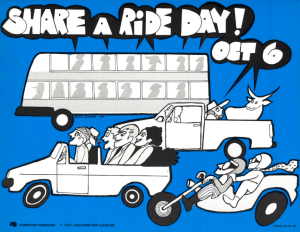
Above is one of the first ‘Share a Ride Day’ flyers of the 1980’s.
As the high-energy 1970s drew to a close, the environmental movement in the United States faced a period of both opportunity and challenge. On the one hand, the Clean Air Act of 1970 and other environmental legislation had laid the groundwork for significant progress in pollution reduction. Public awareness of environmental issues had also grown considerably, thanks to the tireless efforts of activists and organizations like CCA. But the 1980s ushered in a new political climate with the rise of conservative administrations that prioritized business profits and questioned the need for stricter environmental regulations. This shift presented a significant obstacle for environmental groups, who were forced to adapt their strategies and tactics to defend and advance their goals in the face of growing opposition.
In the early 80s, CCA;s media presence increased: we created the country’s first ever Smog Check Program in California and passed SB33 requiring vehicle inspections. We expanded Share-A-Ride day to include computers (yes you read that right, computers), and took the clean air fight to the courts. Later in the decade, the organization hit some snags in the road. With major shifts in the team, CCA became an organization in flux, on a journey to regain its footing. While the 70’s were more about discovering who we were as an organization, the 80’s were about getting work done while trying to keep the organization afloat. In letters from the time, Barbara Sullivan, who became Executive Director in 1981 is credited with solidifying CCA as a professional organization, alongside Sabrina Schiller. Together, their work allowed CCA to expand to have full-time staff, including a full-time scientist. These staff members made the great successes of this decade possible for the Coalition for Clean Air.
California’s Smog Check Program: First in the Nation

As we discussed in our previous blog, Sabrina Schiller was involved in everything CCA did. You won’t be surprised to learn that she is the mind behind the design of the smog check logo we came to see on virtually every garage in California, and the CCA team designed the smog check program itself.
SB33 required vehicle inspections for air pollution control starting in March 1984, but prior to that CCA was working hard to drum up support and publish reports related to regulating vehicles. In 1982, Barbara Sullivan writes, 500 vehicle drivers were polled by CCA at random and nearly 70% voted in favor of annual vehicle inspections, and in a separate poll 97% agreed that air pollution is a serious problem. These results kept CCA engaged and pushing the Smog Check program.
Today we all know that the smog check program required Californians to keep their vehicles cleaner by taking it for a smog test and getting it up to code if it wasn’t in compliance. The Coalition estimated that it would reduce air pollution in major urban areas by 25% as soon as 1987. The impact of the Smog Check program speaks for itself – according to the California Air Resources Board, the Smog Check cuts 400 tons of smog-forming emissions from California’s air each day.
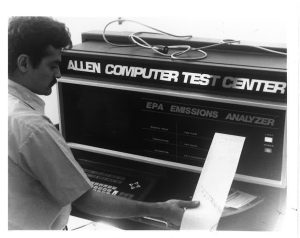
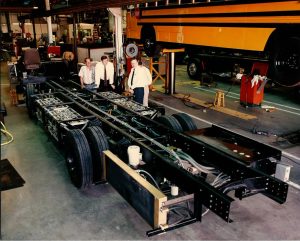
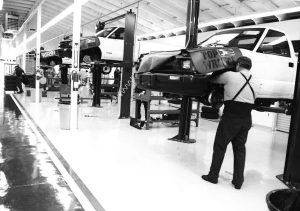
The Commuter Computer
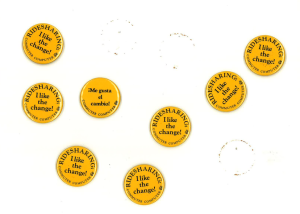
Commuter Computer pins of the 1980’s.
After one Share-A-Ride Day in the 70s a local radio station ran a story about the event and CCA’s work in getting cars off the road. One clever listener, Tad Widby, had a great idea: what if you could use a computer to help people find carpool partners? And Commuter Computer was born.
With Commuter Computer and Share-A-Ride Day partnered up, CCA was able to make carpooling high tech (for the time). They could use modern technology to connect riders with one another and figure out who was taking similar routes. There was even a special edition of Share-A-Ride Day for the 1984 Olympics.
Abramowitz vs EPA
Before we talk about one of the most important cases in environmental history, I want to share a bit more about Mark Abramowitz. Without him, this whole blog series might not have even happened. A simple idea to have Mark on a webinar to discuss this landmark case with the EPA soon had me diving headfirst into the archives of CCA. He was kind, supportive, and answered any question I had. He got me contact info, connected me to Sabrina and helped me understand the air quality space better. So thank you to Mark, who made all of this possible, both with his work with CCA over the years, as well as his gracious support to this history. You can read his story firsthand on our blog or register for our webinar on December 14th to hear from him and ask any of your questions directly.
Much like Sabrina, Mark is an activist, although perhaps he has a slightly more mellow vibe. Where Sabrina can be called a force, Mark is steadfast, working and chipping away at air quality issues from the start. In the words of Sabrina, he “played the longevity game”. He joined CCA in 1980 as a volunteer, later became a staff member, and finally a board member. And he changed the history of air quality in California as a plaintiff in the landmark case Abramowitz Vs. EPA.
The way Mark tells it, the South Coast Air Quality Management District (SCAQMD) had designed and submitted for approval to the EPA an air quality plan for Los Angeles that was far from enough for the region. It was 1984, and there were certain Federal air quality standards the region was supposed to reach by 1987. But the proposal they submitted had no actual plan to meet those in three years, or frankly, at all. Like, ever.
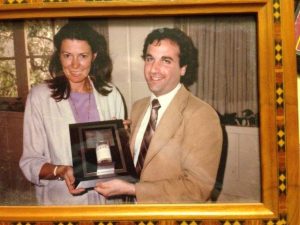
Pictured above are Sabrina Schiller and Mark Abramowitz being awarded by the Coalition for Clean Air in the 1980’s.
As far as Mark was concerned, it just wasn’t going to make the cut. And here’s where there was a critical twist in the plot. A colleague and friend of Mark’s, Lucille Van Osterling, worked at the EPA and gave him a call. She told him that the EPA was about to approve SCAQMD’s completely inadequate “plan.” But most importantly, there was only one week left to file a lawsuit, or the plan would be in place, and it would be “game over for air quality in Los Angeles.”
Mark jumped into action, approaching all the environmental organizations he could, including CCA where he was a Board Member, to a disappointing response: the risk to their reputations as organizations was too great to risk jumping into a lawsuit. So, like any great activist, Mark decided he’d just do it himself.
This is a true David vs. Goliath story. One man going up against the worst polluters in California who have unimaginable power and resources to destroy not just his case, but him. In fact, in his blog of this story he tells us there was a “12-page list of virtually all the utilities in the U.S”…intervening on EPA’s side.
As pressure mounted from all sides – media, utility companies, government agencies, and more – Mark got to work putting together his legal team. As they started building the case, the facts were obvious, and the EPA agreed to settle by implementing a “reasonable extra efforts” program. The EPA’s plan was quickly attacked by polluting industries throughout the country, as well as then-Vice President George Bush. In the face of this powerful pressure, the EPA reneged on the agreement.
In January of 1987, Mark returned to court, and this time he was joined by CCA and several other environmental organizations. Mark describes the case as “a slam dunk,” and in November of 1987 the court ruled in favor of Mark Abramowitz (Victory!). The ruling required the EPA to reject SCAQMD’s air quality attainment plan, which they did. In a letter from an unknown source we’re told “the court went further by calling for the EPA to face up to implementing the measures which are to be triggered by failure to meet attainment.” Take that!
In the next blog, we’ll further explore the fallout and aftermath of this lawsuit, the Federal Implementation Plan, and what will become known as the “Son of Abramowitz” lawsuit.
A Calm Before the Storm
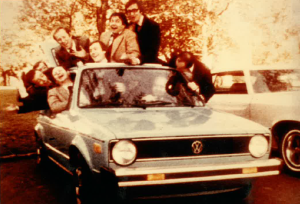 In the mid- to late part of the decade the Coalition experienced a generational shift. Many of the personalities that had made CCA a powerhouse moved on to other things: Barbara Sullivan moved back to Tennessee, Sabrina began law school, and Mark was, as we know, embroiled in a landmark court case. CCA downsized and began sharing an office with Citizens for a Better Environment (which later became Communities for a Better Environment), another small environmental advocacy organization. There was a lull in activity as the team re-grouped and prepared for what was next. I’ll share Ward Elliot’s words of this time:
In the mid- to late part of the decade the Coalition experienced a generational shift. Many of the personalities that had made CCA a powerhouse moved on to other things: Barbara Sullivan moved back to Tennessee, Sabrina began law school, and Mark was, as we know, embroiled in a landmark court case. CCA downsized and began sharing an office with Citizens for a Better Environment (which later became Communities for a Better Environment), another small environmental advocacy organization. There was a lull in activity as the team re-grouped and prepared for what was next. I’ll share Ward Elliot’s words of this time:
“It fell to Ralph Perry and Jan Chatten-Brown – and also to Mark Abramowitz, who…almost single-handedly, and at extraordinary personal sacrifice, kept the office going during its darkest days – to pick up the pieces, retrench to a smaller staff and cheaper office… and rebuild.”
By the end of the 80s, after some of the most notable and lasting accomplishments in its history, CCA was down but far from out.
In our next blogs, we’ll discuss how CCA came back stronger than ever, the many lawsuits of the 90s and Aughts, the work of Mary Nichols, air quality legend, the expansion of CCA, and even some undercover stakeouts. Stick with us as we continue the story and continue the fight for clean air in California!
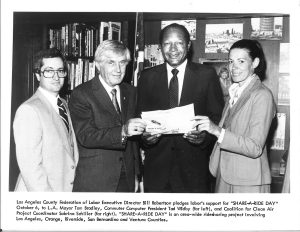
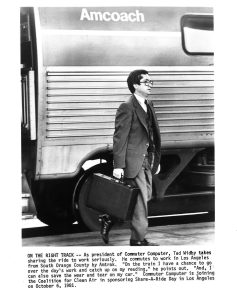
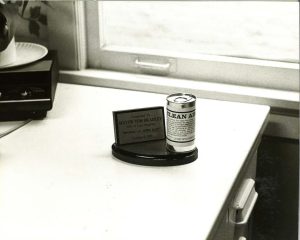
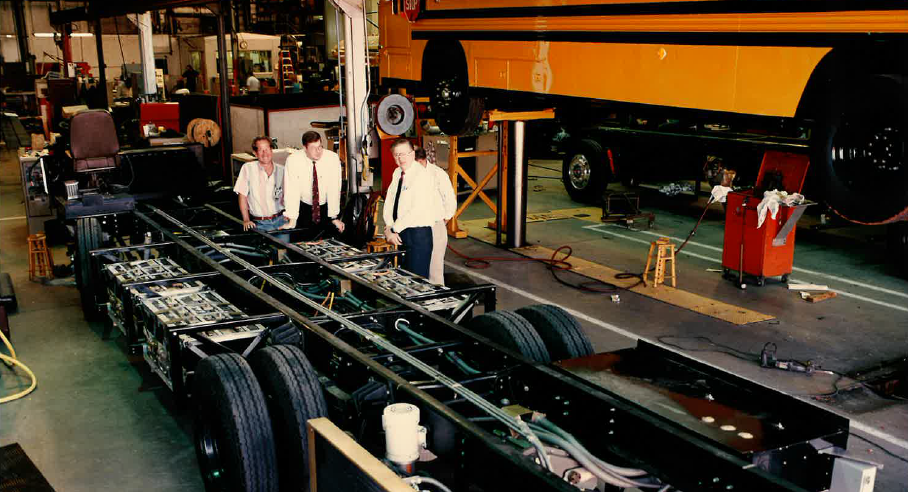
As the Office Director for what was then Citizens for a Better Environment sharing that funky office on Lincoln Blvd on the Santa Monica/Venice border, I can say that sharing office space with CCAir was a collaborative, educational, inspirational, and fun experience. I got to meet some wonderful people including Mark Abramowitz, Sabrina Schiller, Boardmember Ed Begley, Gladys Meade, and other great Boardmembers, Julia Massa, Heidi Love, Tim Little, and many others.
We collaborated on several campaigns and policies vis a vis the SCAQMD including the RECLAIM program, air toxics rules, AB 2588 implementation, and more.
We also hunkered down together during the 1992 Los Angeles riots when mounted police used the Pic & Save parking lot across the street as a staging ground and we ended up closing the office for several days.
Thanks for the memories!
-Woody Hastings,
Phase Out Polluting Fuels Program Manager
The Climate Center